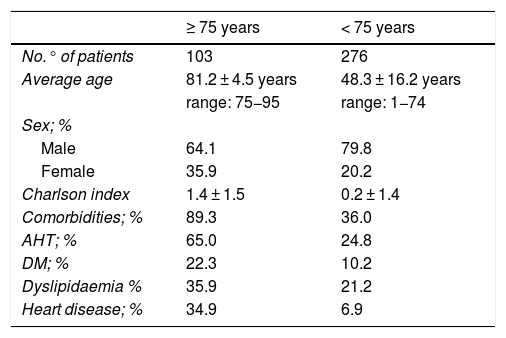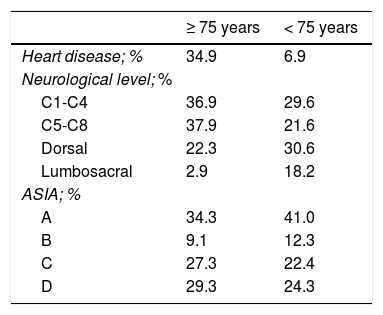To analyze the incidence and characteristics of traumatic spinal cord injury (SCI) in geriatric population of Galicia (Spain), hospital management and functional prognosis
MethodsComparative retrospective study. Patients admitted with acute traumatic SCI during the time period between January 2010 and December 2016 were included. Two groups established: The elderly over and under 75 years of age, with the latter acting as a control group.
Results379 patients were studied (27.2% ≥75 years). The main etiology in the >75 years group were falls: 80.6%. There were 65.7% who presented incomplete spinal cord injuries with mean motor index (MI) of 44.9/100. Upon discharge, 90.8% were dependent. Hospital mortality was 34.9%. Those >75 years suffered from more cervical injuries (74.8 vs. 51.2%, p < 0.001), longer delay in diagnosis (31.1% vs. 9.2%, p < 0.001) and higher hospital mortality (34.9% vs. 3.2%, p < 0.001). Fewer surgical interventions were performed, with a longer delay. Percentages for admission into ICU, mechanical ventilation and performing a tracheostomy proved to be similar. There were no significant differences found in the evolution according to the ASIA scale or the MI.
Conclusions1) The frequency of traumatic SCI in the elderly in Galicia is high. 2) Neurological evolution is similar to younger patients but the level of dependence is higher. 3) The level of care provided is similar in both groups, except for the surgical indication. 4) Hospital mortality is high.
Analizar la incidencia y características de la lesión medular (LM) traumática en la población geriátrica de Galicia (España), el manejo hospitalario y el pronóstico vital y funcional.
Material y métodosEstudio comparativo retrospectivo. Se incluyen los pacientes ingresados por LM traumática aguda entre enero de 2010 y diciembre de 2016. Se establecen dos grupos: mayores y menores de 75 años, actuando los últimos como grupo control.
ResultadosRecogidos 379 pacientes (27,2% ≥75 años). La etiología más frecuente en el grupo ≥75 años fueron las caídas: 80,6%. El 65,7% presentaban lesiones medulares incompletas con un índice motor (IM) medio de 44,9/100. Al alta el 90,8% eran dependientes, precisando silla de ruedas el 53,8%. La mortalidad hospitalaria fue del 34,9%. En comparación con el grupo control, los pacientes mayores sufrieron más lesiones cervicales (74,8 vs 51,2%, p < 0,001), mayor retraso diagnóstico (31,1% vs 9,2%, p < 0,001) y mortalidad hospitalaria (34,9% vs 3,2%, p < 0,001). Se realizaron menos intervenciones quirúrgicas y con mayor demora. Los porcentajes de ingreso en UCI, ventilación mecánica y realización de traqueostomía fueron similares. No se encontraron diferencias significativas en cuanto a evolución neurológica según la escala ASIA (American Spinal Injury Association) (p = 0,46) o el IM (p = 0,48).
Conclusiones1) La frecuencia de LM traumática en ancianos en Galicia es elevada. 2) La evolución neurológica medida por el ASIA es similar a pacientes más jóvenes, si bien el nivel de dependencia al alta es mayor. 3) El nivel de cuidados hospitalarios es similar en ambos grupos salvo por la indicación quirúrgica. 4) La mortalidad hospitalaria es alta.
Article

If it is the first time you have accessed you can obtain your credentials by contacting Elsevier Spain in suscripciones@elsevier.com or by calling our Customer Service at902 88 87 40 if you are calling from Spain or at +34 932 418 800 (from 9 to 18h., GMT + 1) if you are calling outside of Spain.
If you already have your login data, please click here .
If you have forgotten your password you can you can recover it by clicking here and selecting the option ¿I have forgotten my password¿.













